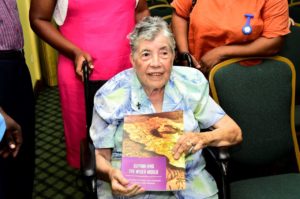red the following books: ‘The Indentured Servants from Bengal to Bush Lot to Belize’ by Karan Chand, ‘Karma Curry’ by Jerry K. Durbeej, ‘Stories set in two Countries’ by Madan M. Gopal, ‘Red Coconut: Bridging the Racial Divide’ by Habeeb Alli, ‘Junta: The Coup is On’ by Ken Puddicombe and ‘Guyanese Writers of Indian Ancestry’ by Petamber Persaud.

We, lovers of literature, can say goodbye to 2017 – the year marking the centennial end to indentureship and the second year of International Decade for People of African Descent – with satisfaction, knowing that some of the books published in this year will follow us into 2018 while others will stay with us decades beyond.
From its inception, the book was treated with respect, even with awe, for man valued the book very highly with regards to its potential as a tool of education and instruction, as a repository for storage and retrieval of information, as a custodian of traditions and languages, as a forum for art and entertainment, stimulating the imagination and improving memory, a source of inspiration, among other usages. And the book has lived up to expectations even in its new forms and formats.
Below are some of the books that crossed my desk during 2017:
Aspects of European-Guyanese Heritage” compiled and edited by the Guyana Heritage Society et al.
This book contains 43 aspects of European/Guyanese heritage showcasing the influence on and contribution to the country via the Spanish, Dutch, Portuguese, French and British through specialist scholarships on architecture, language, religion, foods and beverages, discovery and exploration, flora and fauna, history of wars and colonisation, sugar and slavery and a cursory mention to indentureship.
The book was a collaborative effort among three entities, namely, the European Union, National Trust of Guyana and the Guyana Heritage Society, all of which are deeply involved in the safeguarding particular parts of and, by extension, the world’s heritage.
West Indian history and literature” by Frank Birbalsingh
This very useful document contains 88 reviews of books by eighty-one authors, of which more than one-third are women writers. The themes explored are wide-ranging with far-reaching effects, coming from way back in the past and reaching into the present, including exploitation, incoherence and innovation, psychological mimicry, identity, universal transience, emigration and the diaspora, divisions in race, colour and class, independence and its aftermath.
And the scope of coverage/scholarship extends to numerous countries, all with varying cultural, social issues and political backgrounds, even though all of these countries share a commonality in sugar, slavery, indentureship and colonialism.
Guyana and the Wider World” by Sister Noel Menezes
This is a collection of articles written and addresses made by Sis. Menezes covering a variety of interests, including education, religion, indigenous issues, Portuguese in Guyana, short histories of educational institutions and a few biographies.
Sr. Menezes is the author of several books including Goodall’s “Sketches of Amerindian Tribes”, “British Policy towards the Amerindians in British Guiana, 1803-1873”, “The Amerindians and the Europeans”, “Amerindian Life in Guyana”, “Scenes from the History of the Portuguese in Guyana”, “The Portuguese of Guyana: A Study in Culture and Conflict”.
“The Guyanese Culture – Fusion or Diffusion?” by Rudy Insanally
This is another insightful scholarship by a career diplomat with panache for languages. The book attempts to trace the evolution of Guyanese culture from the days of colonialism and slavery to the present time.
“National Bibliography of Guyana” by the Ministry of Education/GOG
The “National Bibliography of Guyana” is a very ambitious and commendable production despite a few lapses.
The foreword written by Ms. Debra Lowe gives a background to the compilation and eventual completion and publication of the current national bibliography. Ms. Lowe writes that the compilation of this national bibliography “has a long history which began on the 9th October 1945 when His Excellency the Governor, Sir Gordon Lethem K. C. M. G. appointed a Committee for the purpose of ‘compiling and publishing a Bibliography of British Guiana’.” Almost five decades later, Dr. James Rose enters the picture during his tenure as Chairman of the National Library and Vice-Chancellor of the University of Guyana making overtures to the National Trust and the Department of Culture to complete the bibliography. Eventually, the project gained impetus as part of plans for the celebration of Guyana’s Golden Jubilee of Independence when “the idea… was presented to the National Commemoration commission as a marquee Jubilee Project and it was readily embraced”. Subsequently, in 2015 a new committee was formed, leading to the document that is now in the public’s domain.
“Mahaica Belle Rings” by Collette Jones-Chin
Although this book is a memoir, set during the 1970s, in Mahaica – a rural village in Guyana – it is written in such a way redirecting our attention to social issues still traumatising and influencing us in the 21st century. Some of those issues include racial animosity and racial harmony, the role of the family, community spirit in action, growing pains, dealing with sickness and death, the influence of superstition, the use of storytelling and folklore, overcoming fear, reaching for the stars – to be precise, parents and guardians steering their charges in that direction.
Responses to this author please telephone 226-0065 of email: oraltradition2002@yahoo.com
What’s happening:
Over GYD$1,000,000 in prize money up for grabs in the 2018 issue of The Guyana Annual. New closing date for entries to the various competitions is January 15, 2018. For further information go to The Guyana Annual on Facebook or email: theguyanaannual@gmail.com (Guyana Times Sunday Magazine)



